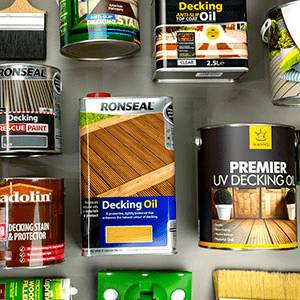Decking Treatment FAQ's
How do I clean decking?
It depends on the issue with the deck. If it's simply dirt, debris and plant matter, decking can be cleaned by sweeping with a stiff bristle broom then treated with a dedicated decking cleaner. For decking that has been affected by mould and algae, sweep with a stiff broom or brush to remove as mush surface matter as possible then treat with a mould and mildew cleaner. heavily soiled decking may require a second treatment.
How do I prepare my garden decking for a new wood finish?
It depends on the type of wood and the finish you want to achieve. Have a look at the first in our series of three blog posts (Garden Decking Stain Treatments - Part #1) about garden decking treatments, how to prepare the wood beforehand and make a great job of it.
What is the best way of achieving a solid black finish on decking?
Black wood finishes on decking have become more popular as they provide a striking contrast against the green hues of grass, trees and other garden plants. Black wood finishes also help to keep the traditional look of exterior wooden beams, barns, doors and window frames. Read more about achieving the perfect black wood finish in our blog.
My decking is slippery, why is this?
Algae growth is the most common cause of slippery decking and can be cleaned using a dedicated Mould and Mildew Cleaner. If the decking is bare wood, a wood preservative treatment should then be applied to help prevent future growth. Treating the decking with a decking oil once the preservative has fully dried will further protect the wood from biological growth and water penetration.
Advice needed on how to make decking non slip?
Slippery decking usually occurs when timber decking boards develop mould, algae or other biological growth, usually identifiable by green or black staining in the wood. This normally happens on bare wood decking that hasn't been treated or previously oiled decking that hasn't been maintained for a number of years.
Remove as much of the surface growth as possible with a stiff broom, brush or scraper. When done, treat the decking with a decking cleaner and one that is designed to kill off mould and algae spores in the wood. Heavily soiled decking may require a second treatment. Then apply an exterior wood preservative to help prevent future biological growth before applying a decking oil. For additional anti-slip properties, use a slip resistant decking oil such as Osmo Anti Slip Decking Oil (430) which is especially good for decking steps.
To stop decking from becoming slippery again, keep well maintained by regularly sweeping off any leaves or other organic matter, cleaning from time to time with a dedicated decking cleaner and then re-oiling as and when necessary.
Is it OK to apply decking oil a couple of days after the first coat?
This is entirely dependent on the product. Some products have wax in their recipe which hardens after a few days. This is a part of the protection so it can repel rain water and other spillages. If this is the case you might struggle to apply the second coat after a longer period of time after the first coat. Double check with the instructions on the tin to be sure.
My decking has a few holes 1-2inches. What do I need to get to fill them please?
Do these holes go right through the wood or only partially through? If they only go partially through then you should be able to fill them with an exterior wood filler. If the hole goes right through the decking board, the best option may be to fill the main bulk of these holes with a piece of wood wedged in then filled as best as possible. Such a large gap or hole that goes all the way through is possibly too big for most fillers to be able to cope with without some sort of mesh of bridge to stop the filler falling through.
So if you are able to get some small pieces to fill these holes as best as possible, and then fill with an exterior filler such as Ronseal Multi Purpose Wood Filler. This filler is durable and has some flexibility, please bare in mind however that decking gets more use and exposure to the elements than any other wood in the garden being horizontal and this can reduce the life of the filler over all, particularly if exposed to standing water. This is a quick fix only option.
For damaged areas of decking it may be better to replace the boards altogether. For further advice please do not hesitate to get in touch to speak with one of our friendly advisers via our contact us page.
Hi, I have a Cuprinol natural oak stain on my decking which is getting patchy looking. I was planning on using a deck cleaner and power washing the stain off to bring back to the original, after allowing sufficient drying time I plan to put on another stain colour, my question is after putting on the stain and allowing it to dry can I put a clear Ronseal decking oil over the stain to protect it from stripping back?
I'm afraid that coating or varnish type decking stains such as the Cuprinol one and penetrative decking oils are not compatible with each other. Many decking stains are surface sealers that dry on top of the wood, giving colour and protection. Deckiing oils are penetrating products that are designed to soak into the the surface of the wood to colour and protect the wood from within.
They are both protective treatments in their own right. So you would need to use one or the other. We often recommend an oiled finish for decking over surface sealers as oils are easier to apply, maintain and repair over time. With any and nearly all decking finishes, good maintenance is the only way to upkeep the protection and a top up annually or bi annually will prevent more work in the long run. We have some great blog posts all about how to best look after your decking which can be found at the bottom of this page.
What decking coating provides best resistance to foot wear. My deck is also the entrance area to my house and previous use of Ronseal decking oil has been disappointing.
Decking is one of the hardest areas of wood to protect, it is exposed 24 hours a day, 365 days a year and any finish can be expected to last for around a year before requiring a top up, refresher or maintenance coat. Oils are the product that we recommend the most for decking, as it is far easier to maintain and repair over time than a surface sealer such as paint or varnish or coating type decking stain.
Oils penetrate the woods surface and protect from within so will not peel or flake over time. When it comes to maintenance, oiled decking can simply be cleaned and re-oiled once dry, no stripping required.
You could consider Ronseal Ultimate Protection Decking Oil that Ronseal claims lasts twice as long as the standard Ronseal Decking Oil. However the Ultimate Decking Oil is water-based where as the standard Ronseal Decking Oil is solvent-based, making them incompatible with each other. If the original oil is well worn away then you are able to clean the surface with Ronseal Decking Cleaner and Reviver and prepare the deck accordingly for application. It is important to do a test area once the decking has been cleaned and dried to ensure the Ultimate Decking Oil will take okay to the decking and that the desired finish will be achieved.
Please advise.... on redwood decking, is it OK to use Liberon Decking Oil (Clear) when I've used Barrentine Premier Wood Preserver and Barrentine Timber Cut end Preserver? I want to use a preservative on the decking and raw ends first but don't know which are compatible with an oil finish.
We often recommend a preservative to be applied before a finishing product, particularly with decking as this will give a better level of protection to the wood overall. The Preservative will help to prevent mould, mildew and rot, whilst decking oils that contain UV filters will slow down the natural silvering process caused by the suns UV rays as well as repelling rain, moisture and liquid spillages.
I would expect the products you have chosen to work together without issue, however as with any product, we always recommend doing test areas to access product compatibility and final finish before committing to any project.
After applying Ronseal Heavy Duty Decking Stain can I put Ronseal Decking Protector on a few weeks later?
The decking protector is designed to go onto bare wood or pressure treated timber, because it needs to penetrate the wood surface. It cannot go over a stain as this will prevent the protector from penetrating the wood.
Does anti-slip decking stain work and how?
Anti-slip decking stains and oils are a great choice for decking steps, decked areas around pools and for commercial decking situated at pubs, clubs, community centers and more. Anti-slip or slip-resistant decking treatments work because they contain small, microscopic particles or beads that dry within the oil or stain once applied. These particles mean that on a microscopic level the surface is covered with tiny lumps and bumps which create more friction between shoes, feet and the treated surface than a standard decking oil or stain. Increased friction means greater slip resistance.
Popular anti-slip or slip resistant decking treatments include...
In terms of anti-slip decking oils, many of these are designed as a top-coat treatment that can be used over existing decking oils, clear and coloured.
Always read the manufacturers information on the tin before starting any project and always do a test area to assess product suitability and final finish.
How often should I oil my decking?
This is like the 'How long is a piece of string' question. Every deck has its own unique characteristics that can include how new or old it is, what type of wood is it made from, Is it south facing or a different direction, how much weather exposure does it get, how much wear does it get and which type of decking oil has been used. Because of all these factors it is impossible to say exactly how long a decking oil will last or to recommend a set maintenance period.
In most cases, oiled decking should be given a fresh maintenance coat at least twice a year, usually in Spring and early Autumn when the day and night air temperatures are above 10° (to assist with drying times) and when dry periods of at least 2 to 3 days can be expected. Decking oil should never be applied in damp, wet or cold conditions.
Decking oils are very easy to apply and maintain, so our recommendation would be to periodically inspect the surface and if the deck is starting to look worn, tired or is losing any of its water repellent properties, simply apply a fresh maintenance coat to restore its look and protective properties.
What are the most common problems with wood decking maintenance?
Part two in our series of three blog posts about garden decking maintenance takes a look at the most common issues faced by DIYers who want to make their decking beautiful, as well as recommending some of the best-performing treatments.
Decking Treatments
Top 5 Decking Treatments
- Ronseal Decking Oil
- Ronseal Ultimate Protection Decking Stain
- Barrettine Decking Oil
- Ronseal Ultimate Protection Decking Oil
- Ronseal Ultimate Protection Decking Paint
Decking related blog posts
- Decking Oil or Stain, Which is Best?
- How to Make Decking Non Slip
- Decking Finish Problems – Sticky Issues
- 7 Common Decking Problems and Solutions
- How to Clean Decking
- Manns UV Decking Oil, The Mann For the Job. The Secret Of Beautiful Decking Exposed.
- Winter Decking Care with Cuprinol
- Top 3 Causes of Damage to Decking and How to Combat Them
Disclaimer: Whilst every attempt has been made to provide product information that is as accurate as possible, it's important to clarify that trees and the wood that they produce can be affected by many factors. For example, the same species of tree grown in the same wood, even in close proximity, will be affected by age along with the amount of sunlight and water they receive. Other naturally occurring biological and environmental factors will also influence the density and grain of the wood as well as the moisture and oil content of the timber. No two trees are the same, meaning each piece of wood has the potential to look and react differently to the same wood finish. For example, product adhesion, colour variations, absorption rates and sheen levels. It is for this reason that we always strongly recommend carrying out test areas before starting any project


